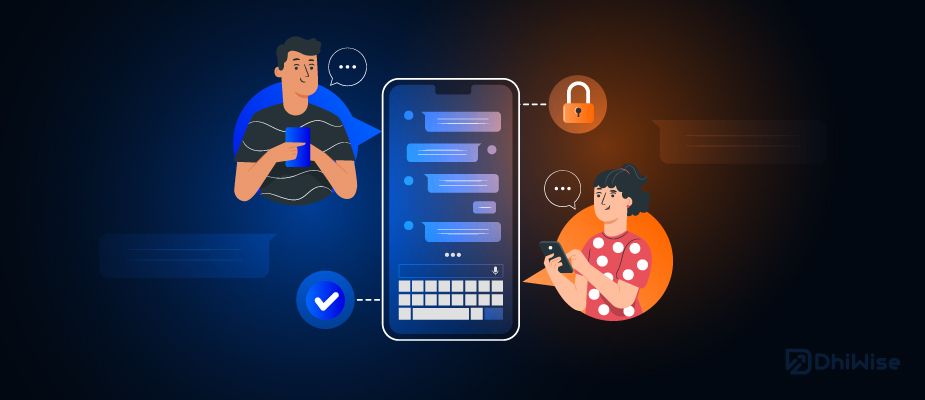Data breaches are becoming increasingly common, so protecting your data is essential. This is where end-to-end encryption comes in. The end-to-end encryption (e2ee) method is where only the intended sender and recipient read the transferred data. In other words, it prevents third parties, such as internet service providers, application service providers, or hackers, from intercepting and reading the data from the sender to the recipient.
How does end-to-end encryption work?
End-to-end encryption utilises cryptographic keys to secure the data. The sender’s device encrypts the data using a public key that can be shared with others. The data is then transmitted securely, and only the recipient’s device can decrypt it using their private key, also known as the decryption key. This ensures that even if a third party accesses the data, it remains unreadable without the recipient’s private key. End-to-end encryption offers enhanced data privacy and security. It benefits sensitive information, such as business documents, financial details, legal proceedings, medical records, or personal conversations. Individuals and organisations can protect their data from unauthorised access, cyber-attacks, and data breaches by employing end-to-end encryption.
End-to-end encryption in action
Notesonline is a leading example of a platform that utilises end-to-end encryption to safeguard user data. With notes online, your notes are encrypted before they leave your device. This means your data is secure during transmission and at rest on your device. Here’s how it works:
- When you create a note, it is encrypted using your public key.
- The encrypted note is then transmitted securely to the recipient’s device.
- The recipient can decrypt the note using their private key, ensuring only they can read its contents.
Additionally, Notes Online offers features like note linking, at-rest encryption, and app lock to enhance your notes’ security further.
Challenges and limitations of end-to-end encryption
While end-to-end encryption provides robust security, it is essential to understand its limitations:
- Limited accessibility for law enforcement: end-to-end encryption prevents law enforcement agencies from accessing data, which can hinder investigations.
- Vulnerability to compromised endpoints: the security of end-to-end encryption relies on the security of the devices used by the sender and recipient. If either device is compromised, it can undermine the effectiveness of the encryption.
- Insecurity of metadata: end-to-end encryption protects the content of the communication but not the associated metadata, such as sender and recipient information, timestamps, etc.
End-to-end encryption is for protecting data privacy and security. By employing this technology, notes online ensures that your notes are secure and accessible only to you. With Notes online, you can rest assured that your data is protected from prying eyes, cyber attacks, and data breaches. So, it offers a beautiful security platform to transform the data. Online notes are one tool that helps send messages with higher privacy within the protected data. They also get through all the secured states of communication, which is associated with the medium of data transformation. To store & encrypted text check of online notes and explore all the features within this portal.
 Kindness and Quiet Help Everyone Enjoy the Office Entertainment Site Together
Kindness and Quiet Help Everyone Enjoy the Office Entertainment Site Together  Machine Learning with Excel: A Beginner’s Guide
Machine Learning with Excel: A Beginner’s Guide  Transforming Singapore’s Transport System The Ultimate Convenience of Promenade Peak
Transforming Singapore’s Transport System The Ultimate Convenience of Promenade Peak  Using CAGR Calculator for Business Revenue Forecasts
Using CAGR Calculator for Business Revenue Forecasts  Chencharu Close Condo Mix Development The Ultimate Address for Modern City Living with Exceptional Transport Links and Future-Ready Amenities
Chencharu Close Condo Mix Development The Ultimate Address for Modern City Living with Exceptional Transport Links and Future-Ready Amenities  How to Prevent Aches and Pains from Everyday Activities
How to Prevent Aches and Pains from Everyday Activities  Expanding Horizons Enrichment Centers and Special Education Institutions Near The Sen Condo
Expanding Horizons Enrichment Centers and Special Education Institutions Near The Sen Condo  How Commercial Cleaning Enhances the Environment in Toledo’s Dental Labs
How Commercial Cleaning Enhances the Environment in Toledo’s Dental Labs  Here’s Why a UAE Trade License is the First Step to Business Success
Here’s Why a UAE Trade License is the First Step to Business Success 




